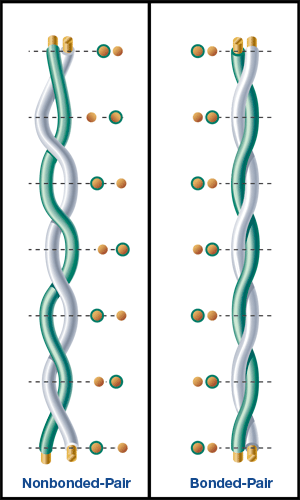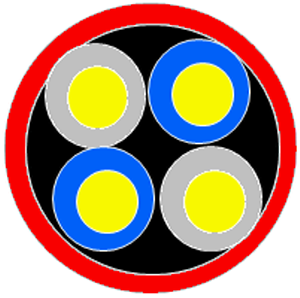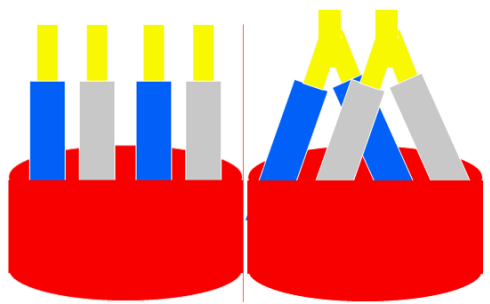How Starquad Works
If you've read the last few blogs, you'll know we've been discussing balanced lines, differential signals, and common-mode noise rejection. But one of the key factors we really haven't discussed is the cable itself.
In the last blog, we talked about how electromagnetic noise signals, called common mode noise, hits both wires in our twisted pair and cancels out. But, to be truthful, the noise is cancelled out only if the two signals are identical. The closer to identical they are, the greater the rejection or common mode rejection ratio, CMRR will be.
We have a saying in cable manufacturing: physicals equal electricals. What this means is that the two wires need to be physically identical if we want the noise signals to also be identical, and the noise rejection to be 100%.
Well, aren't the two wires in a twisted pair 'automatically' identical? After all, we twist those wires together. Isn't that enough? Sure, twisting helps a lot, but it doesn't make the two wires identical. Those two wires should also be the same AWG (gauge) size.
Education or lack of education about the effect of perfect manufacturing process can make all the difference in the ultimate performance of a twisted pair: understanding the importance of calibrating the machines for drawing from bigger wires to smaller wires and for precisely twisting them around each other with the same tension, etc.
If one was a lot tighter with a higher tension on the conductor than the other, then you would be winding one wire around a second straight wire. They wouldn't even be the same length, much less the same resistance. This alone would affect the noise rejection. If the length or wire size is different then one noise signal will be greater than the other and they won't cancel out. If one wire is longer than the other, the noise signal on one wire will arrive earlier than the other. They will be out of phase and again will not cancel out.
But let's say we solved those problems and used two wires of exactly the same size or AWG, the same length and that are twisted with the same tension. There would still be one thing left to compromise our noise rejection: the two wires of the twisted pair are not in the same place.
Think about it. The electromagnetic noise hits one wire and then it hits the other wire. It might be a picosecond later, but that means they do not have identical signals and the noise rejection will not be 100%. Again the signals will be out of phase.
And this is one reason we use Bonded-Pairs, pairs where the two wires are stuck together, without glue! Many of our Category data cables use Bonded-Pairs and now you understand why: no matter how you flex or bend the cable you will still get maximum noise rejection. There are other reasons to bond the two wires which we might talk about in later blogs.
We are beginning now to make Bonded-Pair audio cables. Belden 1353A is the first of these. It's intended for analog or digital audio and features a single bonded twisted pair. This makes it the lowest noise pick-up with the highest CMRR of any audio cable. However, it is not shielded. Since the majority of noise rejection in a twisted pair is because it is a balanced line, the noise rejection of 1353A is excellent, in many applications superior to a shielded cable.
If you need a shield to do something other than shield, such as Phantom Power, where the shield is part of the power delivery to the microphone, well, Belden 1353A won't work there. But, even in a Bonded-Pair, the two wires are not in the same place, the ideal for maximum noise rejection.
Of course, you're going to say that two wires insulated from each other cannot possible be in the same place, right? Wrong! And the way to get two wires in the same place is to start with four wires spiraled together, as shown in the image below.

If you combine the wires across from each other, you end up with a pair.
But look at that first picture of the inside of the cable and think about the electromagnetic noise. By combining the wires, you really do have the two conductors inside each other. Even if you don't believe it, the proof is in what this amazing design can do. For instance, one of the worst noise offenders is 60 Hz power (50 Hz for much of the world).
There is no shield of any kind that we can apply to a cable that has any effect on that low frequency. Even a solid steel conduit, perfectly installed, is only around 30 dB of noise rejection at 60 Hz. But starquad cable is up to 50 dB noise rejection at 60 Hz.
If I were running mic lines near power cables, I definitely would think about starquad! If I was hanging audience microphone from a lighting grid, I definitely would think about starquad.
Belden makes three sizes: Belden 1192A, full size, Belden 1172A small size, and Belden 1804A miniature. The full size is standard mic cable size. The smaller one is excellent for wiring mic booms, or places with restricted space. The miniature is like lavaliere cable.
Since users might be scared of such a small cable, it is made with a special alloy making it super-strong. The conductors in the miniature version are silver-plated to bring the resistance back up to the same value as if it was bare copper. We'd be happy to send you a short sample of any of these. 1-800-235-3361 (1-800-BELDEN-1)
